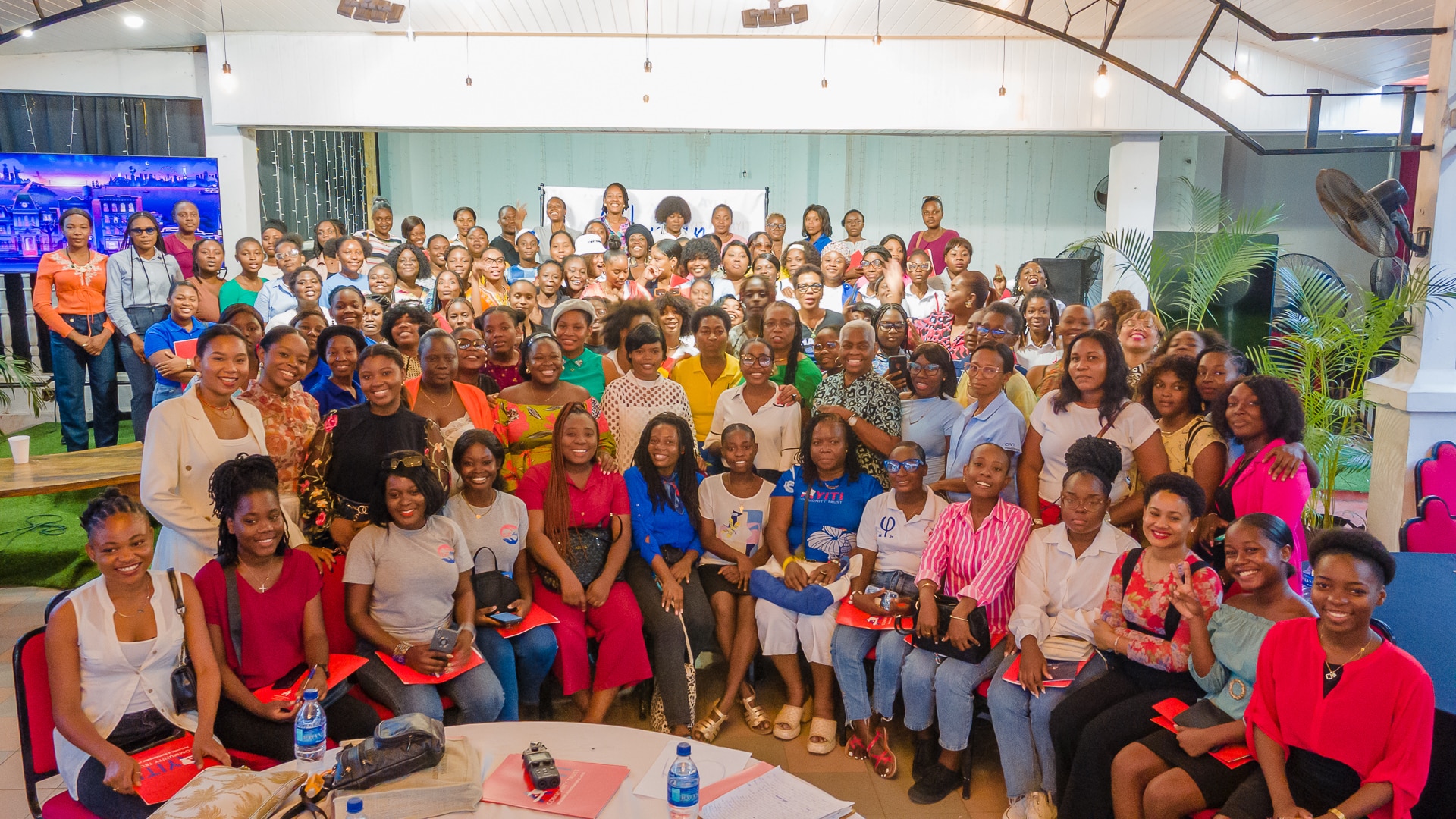
STRENGTHENING WOMEN ENTREPRENEURS IN AYITI
Entrepreneurship is a powerful catalyst for economic growth and social transformation, particularly in communities striving to overcome systemic challenges. In Ayiti, where women play a central role in family and community life, empowering women entrepreneurs has the potential to unlock unprecedented opportunities for sustainable development. Recognizing this, Ayiti Community Trust (ACT), with the generous support of the Damian Braga Fund, hosted the Women’s Entrepreneurship Workshop at the Retrouvailles Complex in Cap-Haitien, Ayiti on January 18, 2025.
This landmark event brought together 300 ambitious young Haitian women to equip them with the tools, connections, and inspiration needed to thrive as entrepreneurs. The workshop was a dynamic blend of practical training, inspirational leadership talks, and collaborative networking, aimed at empowering women to become economic drivers in their communities. Collaborating with esteemed partners like Fondasyon Felicitée, Sakapfet Okap, CLE-Haitian Sisterhood, and Atizan International, the event created an environment of learning, support, and innovation, fostering a collective vision for a brighter future in Ayiti.
The workshop reinforced women's vital role in shaping Ayiti’s economic and social landscapes. By focusing on building skills, confidence, and community, this event marked a significant step toward unlocking the entrepreneurial potential of Haitian women and creating a ripple effect of progress and empowerment across the nation.
SPEAKERS
The workshop featured a distinguished lineup of speakers whose collective expertise, passion, and vision impacted the participants. These leaders shared personal stories, strategic insights, and actionable advice to inspire and equip the young women in attendance:
- Dr. Solanges Vivens: A renowned figure in leadership and community development, Dr. Vivens captivated the audience with her journey of resilience and success. Her keynote address emphasized the transformative power of education, strategic thinking, and unwavering determination, urging participants to envision themselves as trailblazers in their respective fields.
- Mirlene Charles: A celebrated entrepreneur and advocate for women’s empowerment, Mirlene Charles brought practical insights into navigating challenges in the Haitian business landscape. Her talk highlighted the importance of resourcefulness, collaboration, and leveraging local assets, providing a blueprint for sustainable entrepreneurial success.
- Bayyinah Bello: A revered historian, educator, and advocate for cultural empowerment, Bayyinah Bello delivered a powerful address that connected entrepreneurship with Haiti’s rich history and traditions. She emphasized the importance of drawing on one’s cultural identity and values to create businesses that are not only profitable but also deeply rooted in community and purpose. Her perspective resonated deeply, inspiring participants to embrace their heritage as a source of strength and innovation.
This dynamic trio of speakers reinforced the workshop’s central themes of resilience, collaboration, and cultural pride, leaving participants with both practical tools and a renewed sense of purpose to drive transformative change in Haiti. ACT President and Co-Founder, Dr. Guerda Nicolas, and Angie Bell, multi-hyphenate local leader and entrepreneur, partnered to emcee the event with verve and grace. ACT Executive Director, Dr. Alyssa Jean closed the event with a personal story affirming mothers that it's possible to raise a family and pursue their own dreams.
RELIVE (OR IMAGINE) THE EVENT
The workshop began with a vibrant opening ceremony featuring traditional Haitian music and dance performances. This celebratory segment set the tone for the day, honoring Ayiti’s rich cultural heritage and instilling a sense of pride and belonging among the participants.
Dr. Solanges Vivens delivered an inspiring keynote address, sharing her personal journey of resilience, her struggles and triumphs, and her vision for the future of Haitian women entrepreneurs. Her speech emphasized the transformative power of determination and education, providing a roadmap for success and empowerment. Following her keynote, Dr. Vivens engaged directly with participants in an interactive Q&A session. This segment allowed attendees to ask questions, seek advice, and gain deeper insights into overcoming challenges and building successful ventures.
In an engaging interactive session, Mirlene Charles focused on personal and professional development, providing participants with practical strategies for building their confidence, managing resources, and scaling their businesses effectively. The session was hands-on, equipping attendees with actionable tools they could immediately apply.
Small group discussions led by renowned Haitian women entrepreneurs provided an intimate platform for participants to hear real-life stories of navigating challenges, seizing opportunities, and achieving success. These conversations fostered a supportive environment, encouraging open dialogue and exchanging ideas.
The workshop concluded with a dedicated networking session, where participants could mingle, share experiences, and build meaningful connections. This informal gathering encouraged collaboration and the creation of long-term partnerships among attendees.
PARTNERSHIPS
The success of the workshop was built on strong partnerships with local and international organizations that share a commitment to empowering women:
- FONDASYON FELICITÉE: This organization brought its expertise in community development and women's empowerment to the event, contributing to a strong support framework for participants.
- Sakapfet Okap: As a local partner with deep ties to the community, Sakapfet Okap provided logistical support, ensuring the event resonated with the specific needs and challenges of women in the region.
- CLE-Haitian Sisterhood: This group played a key role in fostering solidarity and encouraging the participants to embrace collective empowerment to overcome obstacles.
- Atizan International: A dynamic organization dedicated to promoting Haitian craftsmanship and entrepreneurship, Atizan International brought a unique perspective to the workshop. By showcasing the value of cultural and artisanal industries, they inspired participants to embrace their heritage as a source of entrepreneurial opportunity and innovation. Atizan International’s involvement highlighted the potential of Haitian creativity to drive sustainable economic growth.
These partnerships created a dynamic blend of local relevance and global insights, ensuring participants gained exposure to a broad spectrum of ideas and solutions.
This workshop was not an endpoint but a launchpad for change, a movement that will empower generations of women to redefine Ayiti's future. Through continued support, strategic initiatives, and the collective efforts of individuals and organizations, this initiative promises to inspire resilience, foster innovation, and ultimately shape a brighter, more equitable future for Ayiti.

